
|  |
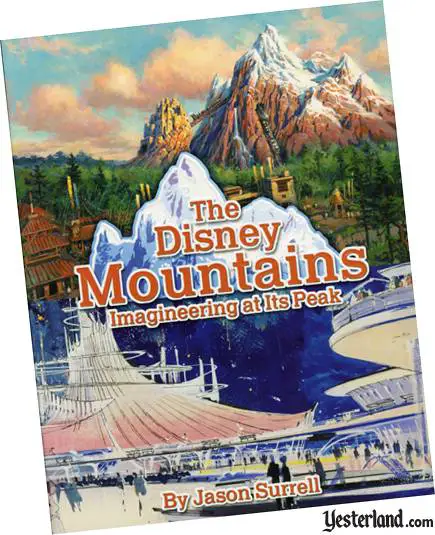
|

Book
Review
The Disney Mountains:
Imagineering
at
Its Peak
Author:
Jason Surrell
Disney
Editions
2007
Reviewed by
Werner Weiss
Sept. 20, 2007
|
“One thing is for certain, as long as human nature draws people to mountains, Imagineering will continue to build them!”
— Tony Baxter in the afterword of The Disney Mountains
I eagerly awaited the arrival of The Disney Mountains: Imagineering at Its Peak because I had enjoyed Jason Surrell’s earlier books about Disney park attractions so much.
When the package arrived a few days ago, the first thing I did was to look at all the pictures.
This 128-page, large-format paperback is full of concept sketches, color renderings, photos of Disney Imagineers at work, and some photos of the finished attractions.
There’s slightly more space devoted to illustrations than to the accompanying text.
Because of the high-quality printing and the smooth, thick paper, the images jump off the page in vibrant colors.
The illustrations are terrific, and it’s fun to compare how different Imagineers approach the same project.
For example, a 1958 Herb Ryman rendering of the Matterhorn features large waterfalls and small lakes at the base.
A few pages later, a 1958 Sam McKim rendering of the Matterhorn features Swiss mountain villages on the side of the faux Swiss mountain—and no waterfalls at all.
(The Matterhorn opened in 1959 with waterfalls, not villages.)
Many of the renderings are not only interesting because of their subject, but also because of their art.
These aren’t just typical architectural renderings; they’re works of art by creative, talented artists.
|
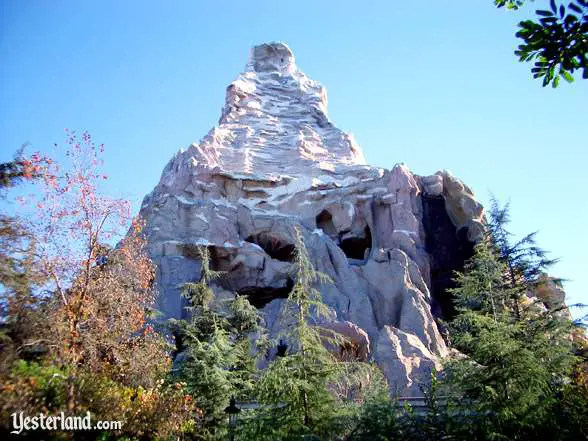
Disney’s first thrilling mountain ride, Matterhorn Bobsleds, will celebrate 50 years in 2009.
|
|
As I repeatedly thumbed through the book admiring the pictures, I started to read a page here and a page there.
The book is organized into chapters and 1- to 2-page articles within those chapters, so that’s easy to do.
Finally, I read the book cover-to-cover.
The Disney Mountains isn’t simply a travel guide to Disney’s “mountain” attractions, such as Space Mountain and Splash Mountain.
It’s really about how and why these mountains became realities—including why Imagineers made their design decisions, ideas that were considered and then abandoned, the engineering that made these rides possible, and even why plans for some attractions spent years gathering dust before they were built.
On the surface, this is a book about rides.
But it’s ultimately a book about the creative process.
Don’t worry.
There’s no lecturing about creative process.
Instead, there are all sorts of fun facts, fascinating stories, and insightful quotes.
Did you know that the plans for Blizzard Beach began as a combination water park and hotel for the site that became Disney’s Coronado Springs Resort?
|

Two other books by Jason Surrell.
|
|
The author, Jason Surrell, is well qualified to write this book.
He works for Disney Imagineering as a Show Writer, so he had access to Imagineering artwork and photographs, as well to many of the Imagineers who worked on these attractions.
It’s obvious that Surrell did extensive research.
Surrell is also the author of
The Haunted Mansion: From the Magic Kingdom to the Movies (2003) and
Pirates of the Caribbean: From the Magic Kingdom to the Movies (2005).
Both are excellent books.
(By the way, the use of “Magic Kingdom” in their titles refers to Disney’s worldwide Magic Kingdoms, not just to Magic Kingdom Park in Florida.)
Surrell has also written or contributed to numerous other Disney books that deal with Imagineering.
|
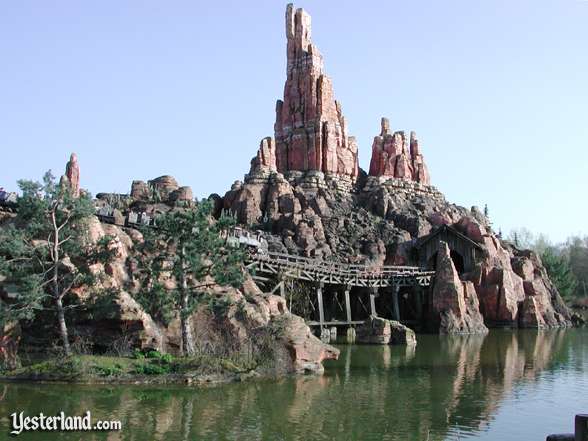
At Disneyland Paris, Big Thunder Mountain Railroad is on an island in the center of Frontierland. .
|
|
By my count there have been 22 Disney mountains (or mountain rides) if you include the short-lived Holiday Hill and the never-built Candy Mountain and Thunder Mesa, as the book does:
- Holiday Hill / Snow Hill at Disneyland (1955, bulldozed 1958)
- Matterhorn Bobsleds at Disneyland (1959, updated in 1977)
- Cascade Peak at Disneyland (1960, demolished 1998)
- Candy Mountain at Disneyland (never built)
- Thunder Mesa, site of Western River Expedition at Magic Kingdom Park (never built)
- Space Mountain at Magic Kingdom Park (1975)
- Space Mountain at Disneyland (1977, relaunched 2005)
- Space Mountain at Tokyo Disneyland (1983)
- Space Mountain at Disneyland Paris (1995)
- Space Mountain at Hong Kong Disneyland (2005)
- Big Thunder Mountain Railroad at Disneyland (1979)
- Big Thunder Mountain Railroad at Magic Kingdom Park (1980)
- Big Thunder Mountain Railroad at Tokyo Disneyland (1987)
- Big Thunder Mountain Railroad at Disneyland Paris (1992)
- Mount Mayday at Disney’s Typhoon Lagoon (1989)
- Mount Gushmore at Disney’s Blizzard Beach (1995)
- Splash Mountain at Disneyland (1989)
- Splash Mountain at Magic Kingdom Park (1992)
- Splash Mountain at Tokyo Disneyland (1992)
- Grizzly Peak, site of Grizzly River Run, at Disney’s California Adventure (2001)
- Mount Prometheus, site of Journey to the Center of the Earth and 20,000 Leagues Under the Sea, at Tokyo DisneySea (2001)
- Expedition Everest—Legend of the Forbidden Mountain
at Disney’s Animal Kingdom Park (2006)
|
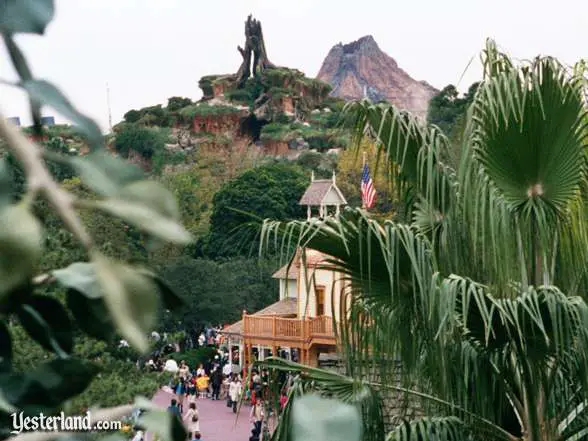
Splash Mountain and Mount Prometheus from Adventureland at Tokyo Disneyland.
|
|
As I read The Disney Mountains, I noticed some cases when I would have preferred to read more.
Disney’s mountain range extends to Disney’s parks in Asia, but Surrell has little about these parks.
Surrell only mentions the July 4, 1987, opening date of “another ‘Monument Valley’ version” of Big Thunder Mountain Railroad in Westernland at Tokyo Disneyland—and that’s within parentheses in a section about the Disneyland Paris version of the ride.
There is nothing at all about Space Mountain at Tokyo Disneyland and Hong Kong Disneyland,
not even a few paragraphs explaining how they compare to their counterparts in Florida, California, and France.
At least Splash Mountain at Tokyo Disneyland fares a little better with two pages about how Tokyo Disneyland added a Critter Country from scratch to have an appropriate setting for Splash Mountain.
There are four pages about Mount Prometheus at Tokyo DisneySea, with two large renderings and two small photographs. However, instead of focusing on the creative process, the accompanying text simply describes Mount Prometheus and the two major attractions within it, the thrilling Journey to the Center of the Earth and the “dry-for-wet” 20,000 Leagues Under the Sea.
|
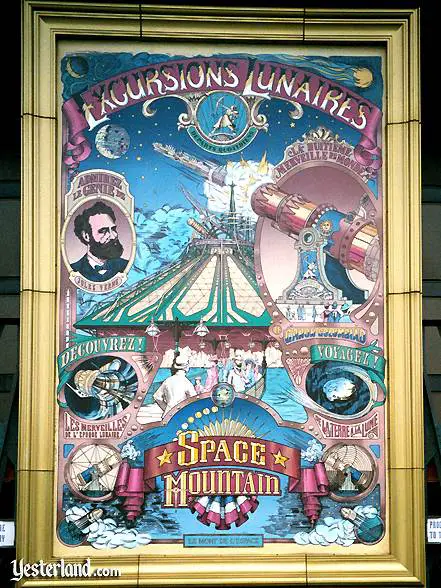
Space Mountain at Disneyland Paris looks to past for inspiration.
|
|
From my perspective, one Disney mountain is conspicuously absent from The Disney Mountains.
The book never mentions Cascade Peak, which opened in 1960 as part of the Mine Train Through Nature’s Wonderland in Frontierland at Disneyland.
Although the little trains stopped running in 1977 to make way for Big Thunder Mountain Railroad, Cascade Peak’s splendid waterfalls continued to pour into Rivers of America.
Over the years, the water took its toll on the peak’s wooden inner structure.
In 1998, the waterfalls were turned off and Cascade Peak was demolished.
Disneyland’s management at that time chose not to maintain or rebuild Cascade Peak.
Please don’t read the preceding paragraph as a serious criticism of the book.
Cascade Peak was not part of a thrill ride; it was not as tall as most other Disney mountains; and many people would not even consider it to be a Disney mountain.
Anybody who was hoping that this book would have renderings or descriptions of the two mountains that figured prominently in Internet rumours of the late 1990s—Fire Mountain and Villain Mountain—will be disappointed.
There’s no mention of them.
Again, this isn’t a criticism of the book.
The Disney Mountains does not have an index.
That’s not a problem when you’re reading the book cover-to-cover, but it makes the book more difficult to use as a reference.
|
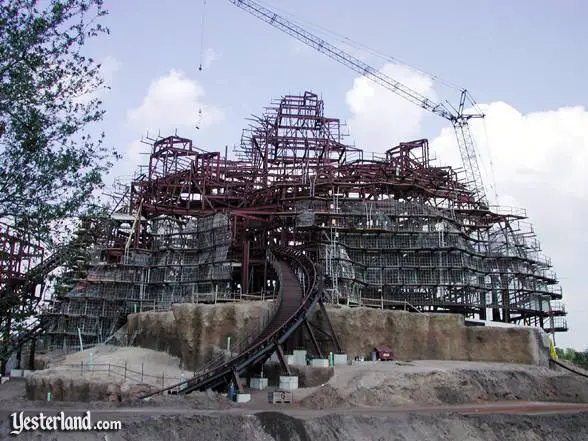
Expedition Everest under construction at Disney’s Animal Kingdom in 2004.
|
|
The Disney Mountains devotes 20 of it 128 pages to a single attraction in a single park: Expedition Everest—Legend of the Forbidden Mountain.
There are five pages devoted just to the Yeti.
In some ways, it’s as if the rest of the book is the introduction to the chapter about Expedition Everest.
In fact, the name of the chapter about Expedition Everest is “Imagineering at Its Peak”—just as in the book’s title.
Expedition Everest is a marvel, and it represents all that Disney Imagineers have learned from the other mountains.
There’s a detailed story that begins before you even get near the ride.
There’s complex engineering, with three intertwined structures that don’t touch each other—a rigid structure for the mountain itself, a more flexible track structure, and a third structure to handle the mighty Yeti and its movements.
Finally, there’s the Yeti itself, one of the crowning achievements of Audio-Animatronics.
The key Imagineers made research trips to the Himalayas to make sure they properly captured the culture, architecture, and customs of the region.
Through meetings with religious leaders, scientists, and local people, they sought to understood the Yeti within that culture.
What a far cry from the first chapter of the book which described how the Imagineers had to design the Matterhorn from pictures in National Geographic and Life magazine, plus a couple of postcards!
|
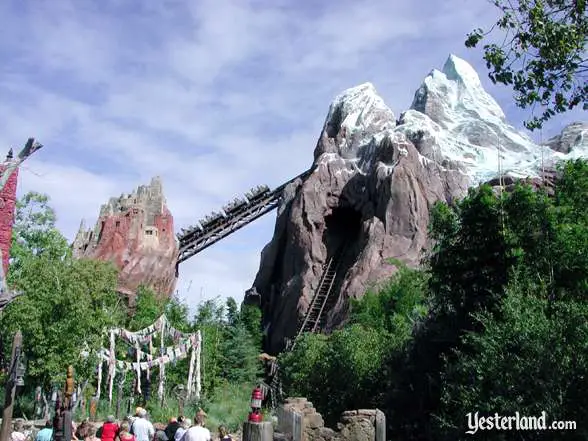
Expedition Everest—Legend of the Forbidden Mountain opened in 2006.
|
|
Despite my disappointment with the coverage of the Disney mountains in Tokyo and Hong Kong, I think this is a excellent book.
It continues the tradition of Surrell’s books about the Haunted Mansion and Pirates of the Caribbean as a “must have” volume for anyone who wants insight into Disney’s greatest attractions.
On a scale of “A” Ticket to “E” Ticket, with “E” Ticket being best, The Disney Mountains earns an “E” Ticket.
|
|
© 2007-2023 Werner Weiss — Disclaimers, Copyright, and Trademarks
Updated July 28, 2023
Scan of The Disney Mountains book cover: © 2007 Disney Enterprises, Inc.
Photo of the Matterhorn at Disneyland: 2003 by Allen Huffman.
Scan of The Haunted Mansion and Pirates of the Caribbean book covers: © 2003 Disney Enterprises, Inc. and © 2005 Disney Enterprises, Inc., respectively
Photo of Thunder Mountain at Disneyland Paris: 2005 by Werner Weiss.
Photo of Splash Mountain and Mount Prometheus at Tokyo Disneyland Resort: 2000 by Werner Weiss.
Photo of Space Mountain poster at Disneyland Paris: 2001 by Werner Weiss.
Photo of Expedition Everest under construction at Disney’s Animal Kingdom: 2004 by Werner Weiss.
Photo of Expedition Everest in operation at Disney’s Animal Kingdom: 2006 by Werner Weiss.
|
|